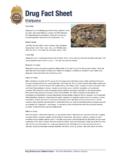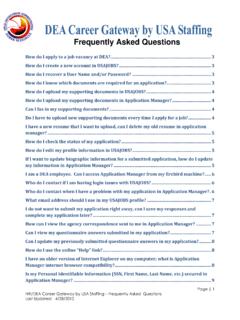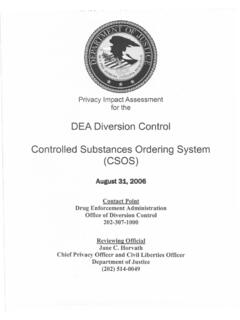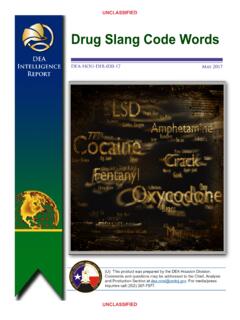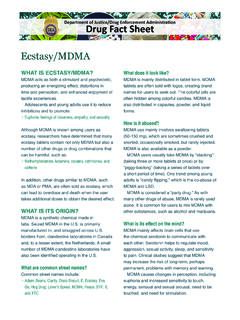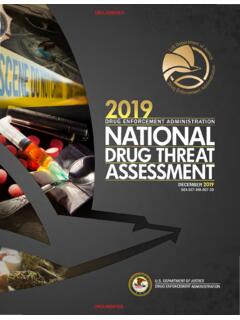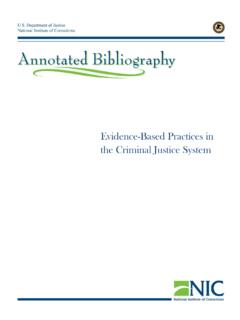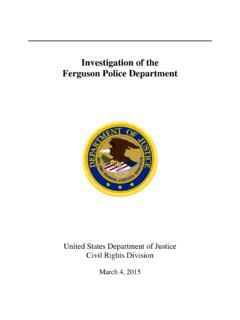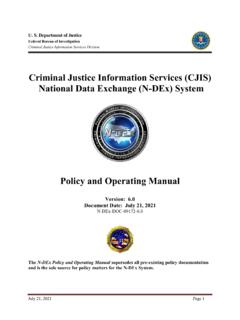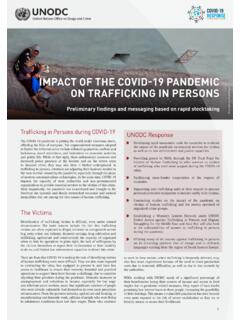Transcription of UNCLASSIFIED - DEA
1 UNCLASSIFIED //LAW ENFORCEMENT SENSITIVEUNCLASSIFIED//LAW ENFORCEMENT SENSITIVEUNCLASSIFIEDUNCLASSIFIEDUNCLASS IFIEDUNCLASSIFIEDThis page intentionally left National Drug Threat AssessmentDrug Enforcement AdministrationThis product was prepared by the DEA Strategic Intelligence Section. Comments and questions may be addressed to the Chief, Analysis and Production Section, at page intentionally left National Drug Threat AssessmentUNCLASSIFIEDUNCLASSIFIEDTABLE OF CONTENTS Letter from the Acting Administrator ..iii Executive Summary ..v Controlled Prescription Drugs ..1 Heroin ..11 Fentanyl and Other Synthetic Opioids ..21 Cocaine ..39 Methamphetamine ..59 Marijuana ..77 New Psychoactive Substances (NPS) ..89 Transnational criminal Organizations ..97 Gangs ..107 Illicit Finance ..123 Puerto Rico and the Virgin Islands ..131 Guam.
2 135 Tribal Lands ..137 Appendix A: Additional Tables ..140 Appendix B: Twenty-Three DEA Field Divisions ..144 Appendix C: National Drug Threat Assessment Scope and Methodology ..145 Appendix D: Acronym Glossary ..1462018 National Drug Threat AssessmentiiUNCLASSIFIEDUNCLASSIFIEDThis page intentionally left National Drug Threat AssessmentUNCLASSIFIEDUNCLASSIFIEDLETTER FROM THE ACTING ADMINISTRATORI am pleased to present the 2018 National Drug Threat Assessment (NDTA), a comprehensive, strategic assessment of the illicit drug threats posed to our NDTA was produced in partnership with local, state, tribal, and federal agencies. It integrates reporting from law enforcement, intelligence, and public health agencies to provide timely, strategic drug-related intelligence to formulate counterdrug policies. Further, it helps law enforcement personnel, educators, and prevention and treatment specialists establish priorities and allocate trafficking and abuse of illicit drugs poses a severe danger to our citizens and a significant challenge for our law enforcement and health care systems.
3 Through robust enforcement, public education, prevention, treatment, and collaboration with our partners, we can protect our citizens from dangerous drugs and their dire you to our partners for their contributions to this report. Your input continues to help us meet the needs of the law enforcement, intelligence, prevention, and treatment provider communities as well as shape counterdrug policies. My colleagues and I at DEA look forward to collaborating on future strategic counterdrug initiatives that impact our national security interests, at home and ,Uttam Dhillon Acting AdministratorDrug Enforcement Administration2018 National Drug Threat AssessmentivUNCLASSIFIEDUNCLASSIFIEDThis page intentionally left National Drug Threat AssessmentUNCLASSIFIEDUNCLASSIFIEDEXECUT IVE SUMMARYF igure 1. Number of Injury Deaths by Drug Poisoning, Suicide, Homicide, Firearms, and Motor Vehicle Crashes in the United States, 1999 20152 Source: Centers for Disease Control and Prevention1 Analyst Note: The information in this report is current as of August Drug overdose deaths are identified using ICD-10 underlying cause-of-death codes X40-X44, X60-X64, X85, and Y10-Y14.
4 Drug overdose deaths involving selected drug categories are identified using ICD-10 multiple cause-of-death codes: heroin, ; natural and semisynthetic opioids, ; methadone, ; synthetic opioids other than methadone, ; cocaine, ; and psychostimulants with abuse potential, Categories are not mutually exclusive because deaths may involve more than one drug. Also, not all states report death data the same or at all to the Centers for Disease Control and Prevention (CDC), meaning nationwide counts of drug overdose deaths, especially deaths by a specific drug(s), may vary from statewide counts. As a result, CDC has stated the true number of drug overdose deaths is almost certainly much higher than the numbers officially 2018 National Drug Threat Assessment (NDTA)1 is a comprehensive strategic assessment of the threat posed to the United States by domestic and international drug trafficking and the abuse of illicit drugs.
5 The report combines federal, state, local, and tribal law enforcement reporting; public health data; open source reporting; and intelligence from other government agencies to determine which substances and criminal organizations represent the greatest threat to the United States. Illicit drugs, as well as the transnational and domestic criminal organizations who traffic them, continue to represent significant threats to public health, law enforcement, and national security in the United States. Drug poisoning deaths are the leading cause of injury death in the United States; they are currently at their highest ever recorded level and, every year since 2011, have outnumbered deaths by firearms, motor vehicle crashes, suicide, and homicide. In 2016, approximately 174 people died every day from drug poisoning (see Figure 1). The opioid threat (controlled prescription drugs, synthetic opioids, and heroin) has reached epidemic levels and currently shows no signs of abating, affecting large portions of the United States.
6 Meanwhile, as the ongoing opioid crisis justly receives national attention, the methamphetamine threat remains prevalent; the cocaine threat has rebounded; new psychoactive substances (NPS) are still challenging; and the domestic marijuana situation continues to evolve. 2018 National Drug Threat AssessmentviUNCLASSIFIEDUNCLASSIFIEDC ontrolled Prescription Drugs (CPDs): CPDs are still responsible for the most drug-involved overdose deaths and are the second most commonly abused substance in the United States. As CPD abuse has increased significantly, traffickers are now disguising other opioids as CPDs in attempts to gain access to new users. Most individuals who report misuse of prescription pain relievers cite physical pain as the most common reason for abuse; these misused pain relievers are most frequently obtained from a friend or : Heroin use and availability continue to increase in the United States.
7 The occurrence of heroin mixed with fentanyl is also increasing. Mexico remains the primary source of heroin available in the United States according to all available sources of intelligence, including law enforcement investigations and scientific data. Further, significant increases in opium poppy cultivation and heroin production in Mexico allow Mexican TCOs to supply high-purity, low-cost heroin, even as demand has continued to and Other Synthetic Opioids: Illicit fentanyl and other synthetic opioids primarily sourced from China and Mexico are now the most lethal category of opioids used in the United States. Traffickers wittingly or unwittingly are increasingly selling fentanyl to users without mixing it with any other controlled substances and are also increasingly selling fentanyl in the form of counterfeit prescription pills. Fentanyl suppliers will continue to experiment with new fentanyl-related substances and adjust supplies in attempts to circumvent new regulations imposed by the United States, China, and Mexico.
8 Cocaine: Cocaine availability and use in the United States have rebounded, in large part due to the significant increases in coca cultivation and cocaine production in Colombia. As a result, past-year cocaine initiates and cocaine-involved overdose deaths are exceeding 2007 benchmark levels. Simultaneously, the increasing presence of fentanyl in the cocaine supply, likely related to the ongoing opioid crisis, is exacerbating the re-merging cocaine : Methamphetamine remains prevalent and widely available, with most of the methamphetamine available in the United States being produced in Mexico and smuggled across the Southwest Border (SWB). Domestic production occurs at much lower levels than in Mexico, and seizures of domestic methamphetamine laboratories have declined steadily for many : Marijuana remains the most commonly used illicit drug in the United States.
9 The overall landscape continues to evolve; although still illegal under Federal law, more states have passed legislation regarding the possession, use, and cultivation of marijuana and its associated products. Although seizure amounts coming across the SWB have decreased in recent years, Mexico remains the most significant foreign source for marijuana available in the United States. Domestic marijuana production continues to increase, as does the availability and production of marijuana-related Psychoactive Substances (NPS): The number of new NPS continues to increase worldwide, but remains a limited threat in the United States compared to other widely available illicit drugs. China remains the primary source for the synthetic cannabinoids and synthetic cathinones that are trafficked into the United States. The availability and popularity of specific NPS in the United States continues to change every year, as traffickers experiment with new and unregulated Transnational criminal Organizations (TCOs): Mexican TCOs remain the greatest criminal drug threat to the United States; no other group is currently positioned to challenge them.
10 The Sinaloa Cartel maintains the most expansive footprint in the United States, while Cartel Jalisco Nueva Generacion s (CJNG) domestic presence has significantly expanded in the past few years. Although 2017 drug-related murders in Mexico surpassed previous levels of violence, Mexican TCO members generally refrain from extending inter-cartel conflicts domestically. vii2018 National Drug Threat AssessmentUNCLASSIFIEDUNCLASSIFIEDC olombian TCOs: Colombian TCOs majority control over the production and supply of cocaine to Mexican TCOs allows Colombian TCOs to maintain an indirect influence on drug markets. Smaller Colombian TCOs still directly supply wholesale quantities of cocaine and heroin to Northeast and East Coast drug markets. Dominican TCOs: Dominican TCOs dominate the mid-level distribution of cocaine and white powder heroin in major drug markets throughout the Northeast, and predominate at the highest levels of the heroin and fentanyl trade in certain areas of the region.
